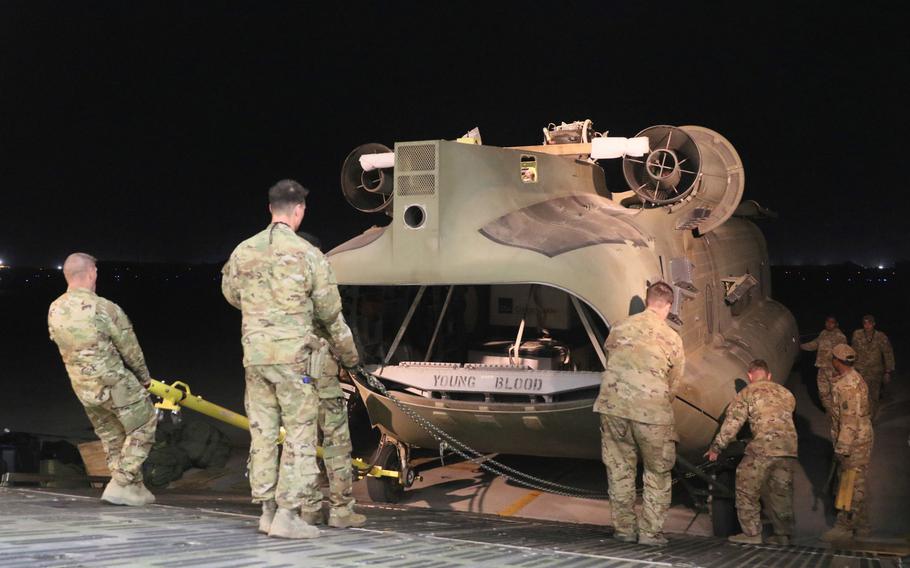
Aerial porters work with maintainers to load a CH-47 Chinook into a C-17 Globemaster III during the drawdown of troops and equipment in Afghanistan, June 16, 2021. The U.S. has completed more than 90% of its withdrawal from the country, a U.S. Central Command statement said July 6, 2021. (Corey Vandiver/U.S. Army)
The United States has completed “more than 90%” of its withdrawal from Afghanistan, U.S. Central Command said in a statement Tuesday.
The statement follows the announcement last week that U.S. and coalition forces had left Bagram Airfield, which for nearly 20 years was the largest U.S. base in the country.
CENTCOM did not say how many U.S. troops remain in Afghanistan. Between 2,500 and 3,500 were in the country when President Joe Biden announced in April that all U.S. forces would withdraw by Sept. 11.
The U.S. has handed over seven facilities to the Afghan Defense Ministry, CENTCOM said in the statement. Pentagon spokesman John Kirby said last week that Bagram was one of the last bases left but that the U.S. military still has facilities in Kabul.
CENTCOM said it will not provide updates of its exit with specific percentages due to security and force protection concerns.
The military has pulled out material equaling 984 C-17 cargo plane loads and handed over more than 17,000 pieces of equipment, mostly excess personal property, to the Defense Logistics Agency for disposition.
Most of those items aren’t considered “major equipment,” the statement said.
A steady stream of goods has been flown to Kuwait on a route established by U.S. Transportation Command and the 1st Theater Sustainment Command, the Army said late last month. The gear is being sorted and cleaned there, and then shipped onward or transferred.
Millions more items are being left behind. Bagram’s new Afghan commander said last week that the U.S. left some 3.5 million items, ranging from bottles of water to civilian trucks and armored vehicles, The Associated Press reported after a visit to the base.
The U.S. withdrawal is expected to be completed by the end of August, officials have said.
About 650 troops are expected to remain to protect the U.S. Embassy in Kabul, while others may be deployed to protect the capital’s airport alongside Turkish troops.
Meanwhile, Taliban gains throughout the country and particularly in the country’s north have led to fears of a government collapse.
The Foundation for Defense of Democracies, which has long tracked Taliban and government territorial rule, estimates the militants have doubled the number of districts in their control since May 1.
Jonathan Schroden, a military operations analyst with a focus on Afghanistan, had for weeks been optimistic that Afghan forces could hold cities and major roads, provided they receive contractor support and continue to fight, he said on Twitter Saturday.
“I’m now concerned about both,” he said in response to reports of large groups of Afghan forces surrendering to the Taliban.